Freshwater Aquaculture Mapping in “Home of Chinese Crawfish” by Using a Hierarchical Classification Framework and Sentinel-1/2 Data
Abstract
1. Introduction
2. Materials and Methods
2.1. Study Area
2.2. Sentinel-1/2 Data
2.3. The Spectral Distinctiveness between Aquaculture Ponds and Rice-Crawfish Fields
2.4. A Hierarchical Framework for Fine Classification Inland Freshwater Aquaculture
2.4.1. Extraction of Potential Inland Aquaculture Areas
2.4.2. Machine Learning Classifiers and Hyperparameter Tuning
2.4.3. Selection of Optimal Classifier and Feature Combination
2.4.4. Fine Classification of Inland Aquaculture Areas
2.5. Accuracy Assessment
3. Results
3.1. The Accuracy Assessment of Four Machine Learning Classifiers under Different Feature Combinations
3.2. Separability Analysis
3.3. Aquaculture Area Maps under the Optimal Feature Combinations for Different Classifiers
3.4. Fine Classification Results of Inland Aquaculture Areas in Qianjiang, 2023
4. Discussion
4.1. Assessment of Classifiers and Feature Combinations
4.2. Improvements in Fine Classification of Inland Freshwater Aquaculture Areas
4.3. Future Prospects and Limitations
5. Conclusions
Author Contributions
Funding
Data Availability Statement
Acknowledgments
Conflicts of Interest
References
- Edwards, P.; Zhang, W.; Belton, B.; Little, D. Misunderstandings, Myths and Mantras in Aquaculture: Its Contribution to World Food Supplies Has Been Systematically over Reported. Mar. Policy 2019, 106, 103547. [Google Scholar] [CrossRef]
- The State of World Fisheries and Aquaculture 2022; FAO: Rome, Italy, 2022; ISBN 978-92-5-136364-5.
- Zhang, W.; Belton, B.; Edwards, P.; Henriksson, P.J.G.; Little, D.C.; Newton, R.; Troell, M. Aquaculture Will Continue to Depend More on Land than Sea. Nature 2022, 603, E2–E4. [Google Scholar] [CrossRef] [PubMed]
- Wei, Y.; Müller, D.; Sun, Z.; Lu, M.; Tang, H.; Wu, W. Exploring the Emergence and Changing Dynamics of a New Integrated Rice-Crawfish Farming System in China. Environ. Res. Lett. 2023, 18, 064040. [Google Scholar] [CrossRef]
- Wang, M.; Mao, D.; Xiao, X.; Song, K.; Jia, M.; Ren, C.; Wang, Z. Interannual Changes of Coastal Aquaculture Ponds in China at 10-m Spatial Resolution during 2016–2021. Remote Sens. Environ. 2023, 284, 113347. [Google Scholar] [CrossRef]
- Wang, Z.; Zhang, J.; Yang, X.; Huang, C.; Su, F.; Liu, X.; Liu, Y.; Zhang, Y. Global Mapping of the Landside Clustering of Aquaculture Ponds from Dense Time-Series 10 m Sentinel-2 Images on Google Earth Engine. Int. J. Appl. Earth Obs. Geoinf. 2022, 115, 103100. [Google Scholar] [CrossRef]
- Ottinger, M.; Bachofer, F.; Huth, J.; Kuenzer, C. Mapping Aquaculture Ponds for the Coastal Zone of Asia with Sentinel-1 and Sentinel-2 Time Series. Remote Sens. 2022, 14, 153. [Google Scholar] [CrossRef]
- Cai, Z.; Wei, H.; Hu, Q.; Zhou, W.; Zhang, X.; Jin, W.; Wang, L.; Yu, S.; Wang, Z.; Xu, B.; et al. Learning Spectral-Spatial Representations from VHR Images for Fine-Scale Crop Type Mapping: A Case Study of Rice-Crayfish Field Extraction in South China. ISPRS J. Photogramm. Remote Sens. 2023, 199, 28–39. [Google Scholar] [CrossRef]
- Sun, Z.; Luo, J.; Yang, J.; Yu, Q.; Zhang, L.; Xue, K.; Lu, L. Nation-Scale Mapping of Coastal Aquaculture Ponds with Sentinel-1 SAR Data Using Google Earth Engine. Remote Sens. 2020, 12, 3086. [Google Scholar] [CrossRef]
- Ottinger, M.; Clauss, K.; Kuenzer, C. Aquaculture: Relevance, Distribution, Impacts and Spatial Assessments—A Review. Ocean Coast. Manag. 2016, 119, 244–266. [Google Scholar] [CrossRef]
- Zhou, Y.; Dong, J.; Cui, Y.; Zhao, M.; Wang, X.; Tang, Q.; Zhang, Y.; Zhou, S.; Metternicht, G.; Zou, Z.; et al. Ecological Restoration Exacerbates the Agriculture-Induced Water Crisis in North China Region. Agric. For. Meteorol. 2023, 331, 109341. [Google Scholar] [CrossRef]
- Ray, N.E.; Holgerson, M.A.; Andersen, M.R.; Bikše, J.; Bortolotti, L.E.; Futter, M.; Kokorīte, I.; Law, A.; McDonald, C.; Mesman, J.P.; et al. Spatial and Temporal Variability in Summertime Dissolved Carbon Dioxide and Methane in Temperate Ponds and Shallow Lakes. Limnol. Oceanogr. 2023, 68, 1530–1545. [Google Scholar] [CrossRef]
- Rosentreter, J.A.; Borges, A.V.; Deemer, B.R.; Holgerson, M.A.; Liu, S.; Song, C.; Melack, J.; Raymond, P.A.; Duarte, C.M.; Allen, G.H.; et al. Half of Global Methane Emissions Come from Highly Variable Aquatic Ecosystem Sources. Nat. Geosci. 2021, 14, 225–230. [Google Scholar] [CrossRef]
- Liu, C.; Hu, N.; Song, W.; Chen, Q.; Zhu, L. Aquaculture Feeds Can Be Outlaws for Eutrophication When Hidden in Rice Fields? A Case Study in Qianjiang, China. Int. J. Environ. Res. Public. Health 2019, 16, 4471. [Google Scholar] [CrossRef]
- Zhang, L.; Song, Z.; Zhou, Y.; Zhong, S.; Yu, Y.; Liu, T.; Gao, X.; Li, L.; Kong, C.; Wang, X.; et al. The Accumulation of Toxic Elements (Pb, Hg, Cd, As, and Cu) in Red Swamp Crayfish (Procambarus Clarkii) in Qianjiang and the Associated Risks to Human Health. Toxics 2023, 11, 635. [Google Scholar] [CrossRef]
- Li, H.; Li, H.; Zhang, H.; Cao, J.; Ge, T.; Gao, J.; Fang, Y.; Ye, W.; Fang, T.; Shi, Y.; et al. Trace Elements in Red Swamp Crayfish (Procambarus Clarkii) in China: Spatiotemporal Variation and Human Health Implications. Sci. Total Environ. 2023, 857, 159749. [Google Scholar] [CrossRef]
- Wei, Y.; Lu, M.; Yu, Q.; Xie, A.; Hu, Q.; Wu, W. Understanding the Dynamics of Integrated Rice–Crawfish Farming in Qianjiang County, China Using Landsat Time Series Images. Agric. Syst. 2021, 191, 103167. [Google Scholar] [CrossRef]
- Xia, T.; He, Z.; Cai, Z.; Wang, C.; Wang, W.; Wang, J.; Hu, Q.; Song, Q. Exploring the Potential of Chinese GF-6 Images for Crop Mapping in Regions with Complex Agricultural Landscapes. Int. J. Appl. Earth Obs. Geoinf. 2022, 107, 102702. [Google Scholar] [CrossRef]
- Xia, T.; Ji, W.; Li, W.; Zhang, C.; Wu, W. Phenology-Based Decision Tree Classification of Rice-Crayfish Fields from Sentinel-2 Imagery in Qianjiang, China. Int. J. Remote Sens. 2021, 42, 8124–8144. [Google Scholar] [CrossRef]
- Xia, Z.; Guo, X.; Chen, R. Automatic Extraction of Aquaculture Ponds Based on Google Earth Engine. Ocean Coast. Manag. 2020, 198, 105348. [Google Scholar] [CrossRef]
- Zeng, Z.; Wang, D.; Tan, W.; Huang, J. Extracting Aquaculture Ponds from Natural Water Surfaces around Inland Lakes on Medium Resolution Multispectral Images. Int. J. Appl. Earth Obs. Geoinf. 2019, 80, 13–25. [Google Scholar] [CrossRef]
- People’s Government of Qianjiang City Summary of the City’s Crawfish Industry in 2021 and Priorities for 2022. Available online: http://www.hbqj.gov.cn/xwzx/ztbd/qjlxsjgx/ghzj/202211/t20221107_4392034.html (accessed on 7 November 2023).
- China Fisheries Society 2022 China Crayfish Industry Development Report. Available online: http://www.china-cfa.org/xwzx/xydt/2022/0531/732.html (accessed on 7 November 2023).
- Drusch, M.; Del Bello, U.; Carlier, S.; Colin, O.; Fernandez, V.; Gascon, F.; Hoersch, B.; Isola, C.; Laberinti, P.; Martimort, P.; et al. Sentinel-2: ESA’s Optical High-Resolution Mission for GMES Operational Services. Remote Sens. Environ. 2012, 120, 25–36. [Google Scholar] [CrossRef]
- Abdi, A.M. Land Cover and Land Use Classification Performance of Machine Learning Algorithms in a Boreal Landscape Using Sentinel-2 Data. GIScience Remote Sens. 2020, 57, 1–20. [Google Scholar] [CrossRef]
- Oreopoulos, L.; Wilson, M.J.; Várnai, T. Implementation on Landsat Data of a Simple Cloud-Mask Algorithm Developed for MODIS Land Bands. IEEE Geosci. Remote Sens. Lett. 2011, 8, 597–601. [Google Scholar] [CrossRef]
- You, N.; Dong, J.; Huang, J.; Du, G.; Zhang, G.; He, Y.; Yang, T.; Di, Y.; Xiao, X. The 10-m Crop Type Maps in Northeast China during 2017–2019. Sci. Data 2021, 8, 41. [Google Scholar] [CrossRef] [PubMed]
- Xu, H. Modification of Normalised Difference Water Index (NDWI) to Enhance Open Water Features in Remotely Sensed Imagery. Int. J. Remote Sens. 2006, 27, 3025–3033. [Google Scholar] [CrossRef]
- Huete, A.; Didan, K.; Miura, T.; Rodriguez, E.P.; Gao, X.; Ferreira, L.G. Overview of the Radiometric and Biophysical Performance of the MODIS Vegetation Indices. Remote Sens. Environ. 2002, 83, 195–213. [Google Scholar] [CrossRef]
- Gorelick, N.; Hancher, M.; Dixon, M.; Ilyushchenko, S.; Thau, D.; Moore, R. Google Earth Engine: Planetary-Scale Geospatial Analysis for Everyone. Remote Sens. Environ. 2017, 202, 18–27. [Google Scholar] [CrossRef]
- Zhou, Y.; Dong, J.; Cui, Y.; Zhou, S.; Li, Z.; Wang, X.; Deng, X.; Zou, Z.; Xiao, X. Rapid Surface Water Expansion Due to Increasing Artificial Reservoirs and Aquaculture Ponds in North China Plain. J. Hydrol. 2022, 608, 127637. [Google Scholar] [CrossRef]
- Gxokwe, S.; Dube, T.; Mazvimavi, D. Leveraging Google Earth Engine Platform to Characterize and Map Small Seasonal Wetlands in the Semi-Arid Environments of South Africa. Sci. Total Environ. 2022, 803, 150139. [Google Scholar] [CrossRef]
- Ouma, Y.O.; Keitsile, A.; Nkwae, B.; Odirile, P.; Moalafhi, D.; Qi, J. Urban Land-Use Classification Using Machine Learning Classifiers: Comparative Evaluation and Post-Classification Multi-Feature Fusion Approach. Eur. J. Remote Sens. 2023, 56, 2173659. [Google Scholar] [CrossRef]
- Pizarro, S.E.; Pricope, N.G.; Vargas-Machuca, D.; Huanca, O.; Ñaupari, J. Mapping Land Cover Types for Highland Andean Ecosystems in Peru Using Google Earth Engine. Remote Sens. 2022, 14, 1562. [Google Scholar] [CrossRef]
- Breiman, L. Random Forests. Mach. Learn. 2001, 45, 5–32. [Google Scholar] [CrossRef]
- Vapnik, V.N. The Nature of Statistical Learning Theory; Springer New York: New York, NY, USA, 2000; ISBN 978-1-4419-3160-3. [Google Scholar]
- Liu, W.; Liang, S.; Qin, X. Weighted P-Norm Distance t Kernel SVM Classification Algorithm Based on Improved Polarization. Sci. Rep. 2022, 12, 6197. [Google Scholar] [CrossRef] [PubMed]
- Mountrakis, G.; Im, J.; Ogole, C. Support Vector Machines in Remote Sensing: A Review. ISPRS J. Photogramm. Remote Sens. 2011, 66, 247–259. [Google Scholar] [CrossRef]
- Roy, A.; Chakraborty, S. Support Vector Machine in Structural Reliability Analysis: A Review. Reliab. Eng. Syst. Saf. 2023, 233, 109126. [Google Scholar] [CrossRef]
- Simioni, J.P.D.; Guasselli, L.A.; de Oliveira, G.G.; Ruiz, L.F.C.; de Oliveira, G. A Comparison of Data Mining Techniques and Multi-Sensor Analysis for Inland Marshes Delineation. Wetl. Ecol. Manag. 2020, 28, 577–594. [Google Scholar] [CrossRef]
- Giroux-Bougard, X. Multi-Sensor Detection of Spring Breakup Phenology of Canada’s Lakes. Remote Sens. Environ. 2023, 295, 113656. [Google Scholar] [CrossRef]
- Zhang, F.; Yang, X. Improving Land Cover Classification in an Urbanized Coastal Area by Random Forests: The Role of Variable Selection. Remote Sens. Environ. 2020, 251, 112105. [Google Scholar] [CrossRef]
- Friedman, J.H. Stochastic Gradient Boosting. Comput. Stat. Data Anal. 2002, 38, 367–378. [Google Scholar] [CrossRef]
- Zhou, B.; Okin, G.S.; Zhang, J. Leveraging Google Earth Engine (GEE) and Machine Learning Algorithms to Incorporate in Situ Measurement from Different Times for Rangelands Monitoring. Remote Sens. Environ. 2020, 236, 111521. [Google Scholar] [CrossRef]
- Haralick, R.M.; Shanmugam, K.; Dinstein, I. Textural Features for Image Classification. IEEE Trans. Syst. Man Cybern. 1973, SMC-3, 610–621. [Google Scholar] [CrossRef]
- Xu, Y.; Hu, Z.; Zhang, Y.; Wang, J.; Yin, Y.; Wu, G. Mapping Aquaculture Areas with Multi-Source Spectral and Texture Features: A Case Study in the Pearl River Basin (Guangdong), China. Remote Sens. 2021, 13, 4320. [Google Scholar] [CrossRef]
- Olofsson, P.; Foody, G.M.; Stehman, S.V.; Woodcock, C.E. Making Better Use of Accuracy Data in Land Change Studies: Estimating Accuracy and Area and Quantifying Uncertainty Using Stratified Estimation. Remote Sens. Environ. 2013, 129, 122–131. [Google Scholar] [CrossRef]
- Richards, J.A. Remote Sensing Digital Image Analysis; Springer: Berlin/Heidelberg, Germany, 1993; ISBN 978-3-540-58219-9. [Google Scholar]
- Davis, S.M.; Landgrebe, D.A.; Phillips, T.L.; Swain, P.H.; Hoffer, R.M.; Lindenlaub, J.C.; Silva, L.F. Remote Sensing: The Quantitative Approach; McGraw-Hill International Book Co.: New York, NY, USA, 1978. [Google Scholar]
- Kim, R.S.; Durand, M.; Liu, D. Spectral Analysis of Airborne Passive Microwave Measurements of Alpine Snowpack: Colorado, USA. Remote Sens. Environ. 2018, 205, 469–484. [Google Scholar] [CrossRef]
- Yang, Y.; Yang, D.; Wang, X.; Zhang, Z.; Nawaz, Z. Testing Accuracy of Land Cover Classification Algorithms in the Qilian Mountains Based on GEE Cloud Platform. Remote Sens. 2021, 13, 5064. [Google Scholar] [CrossRef]
- Pan, X.; Wang, Z.; Gao, Y.; Dang, X.; Han, Y. Detailed and Automated Classification of Land Use/Land Cover Using Machine Learning Algorithms in Google Earth Engine. Geocarto Int. 2022, 37, 5415–5432. [Google Scholar] [CrossRef]
- Han, Y.; Huang, J.; Ling, F.; Qiu, J.; Liu, Z.; Li, X.; Chang, C.; Chi, H. Dynamic Mapping of Inland Freshwater Aquaculture Areas in Jianghan Plain, China. IEEE J. Sel. Top. Appl. Earth Obs. Remote Sens. 2023, 16, 4349–4361. [Google Scholar] [CrossRef]
- Ren, C.; Wang, Z.; Zhang, Y.; Zhang, B.; Chen, L.; Xi, Y.; Xiao, X.; Doughty, R.B.; Liu, M.; Jia, M.; et al. Rapid Expansion of Coastal Aquaculture Ponds in China from Landsat Observations during 1984–2016. Int. J. Appl. Earth Obs. Geoinf. 2019, 82, 101902. [Google Scholar] [CrossRef]
- Chen, J.; Chen, J.; Liao, A.; Cao, X.; Chen, L.; Chen, X.; He, C.; Han, G.; Peng, S.; Lu, M.; et al. Global Land Cover Mapping at 30m Resolution: A POK-Based Operational Approach. ISPRS J. Photogramm. Remote Sens. 2015, 103, 7–27. [Google Scholar] [CrossRef]
- Rosier, J.F.; Taubenböck, H.; Verburg, P.H.; van Vliet, J. Fusing Earth Observation and Socioeconomic Data to Increase the Transferability of Large-Scale Urban Land Use Classification. Remote Sens. Environ. 2022, 278, 113076. [Google Scholar] [CrossRef]
- Zhong, Y.; Su, Y.; Wu, S.; Zheng, Z.; Zhao, J.; Ma, A.; Zhu, Q.; Ye, R.; Li, X.; Pellikka, P.; et al. Open-Source Data-Driven Urban Land-Use Mapping Integrating Point-Line-Polygon Semantic Objects: A Case Study of Chinese Cities. Remote Sens. Environ. 2020, 247, 111838. [Google Scholar] [CrossRef]
- Zhong, Y.; Yan, B.; Yi, J.; Yang, R.; Xu, M.; Su, Y.; Zheng, Z.; Zhang, L. Global Urban High-Resolution Land-Use Mapping: From Benchmarks to Multi-Megacity Applications. Remote Sens. Environ. 2023, 298, 113758. [Google Scholar] [CrossRef]
- Zhou, W.; Persello, C.; Li, M.; Stein, A. Building Use and Mixed-Use Classification with a Transformer-Based Network Fusing Satellite Images and Geospatial Textual Information. Remote Sens. Environ. 2023, 297, 113767. [Google Scholar] [CrossRef]

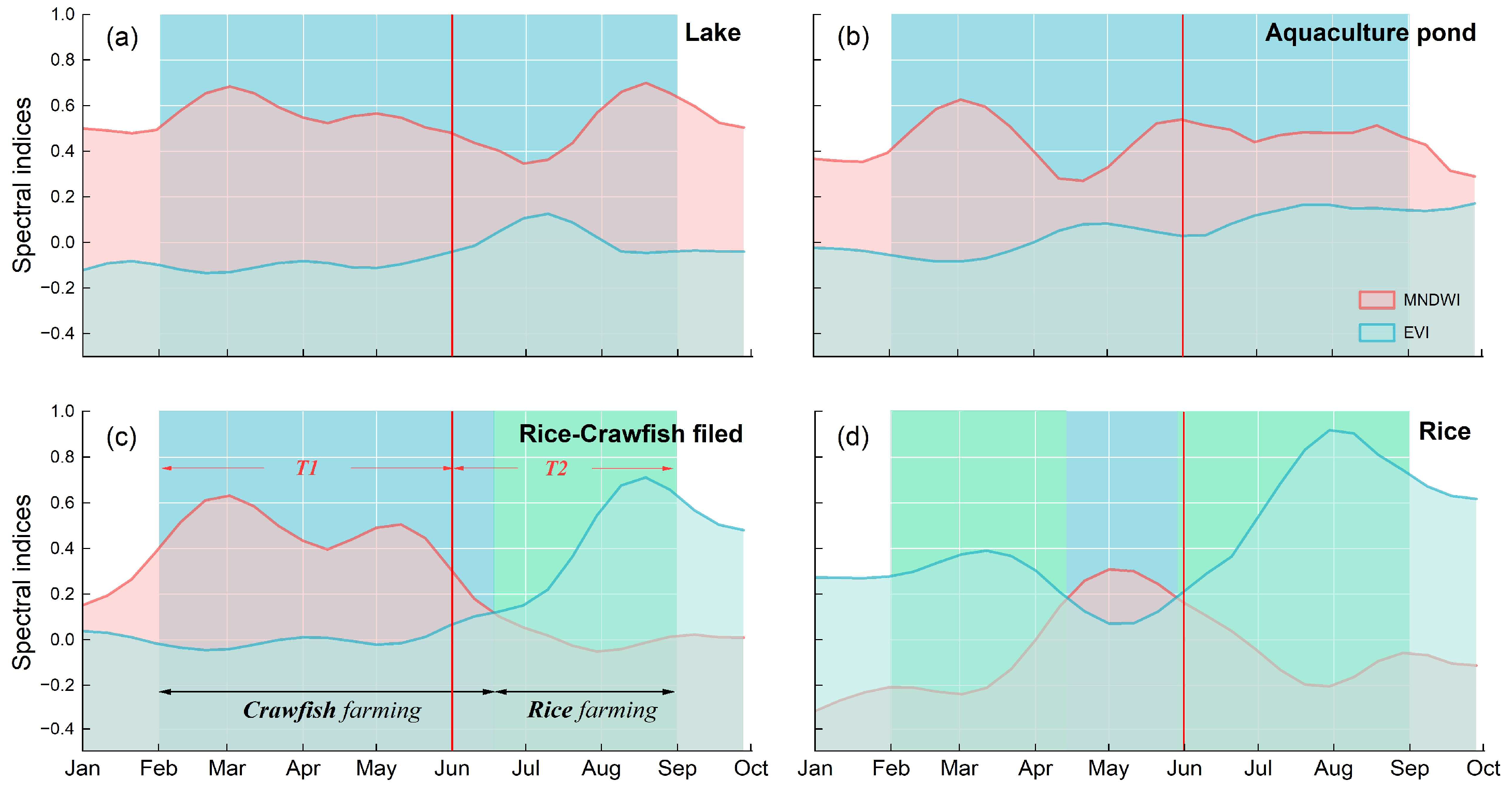
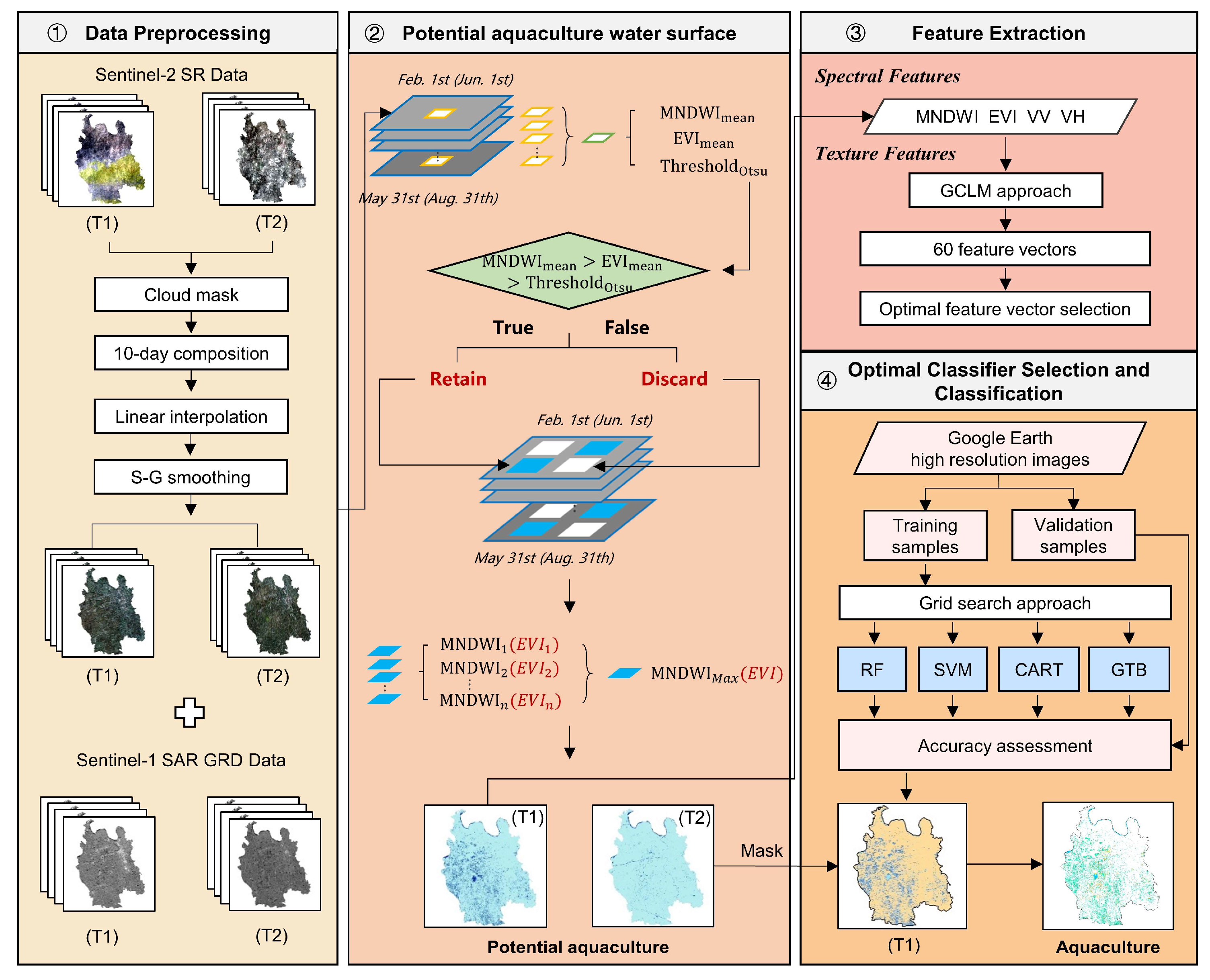
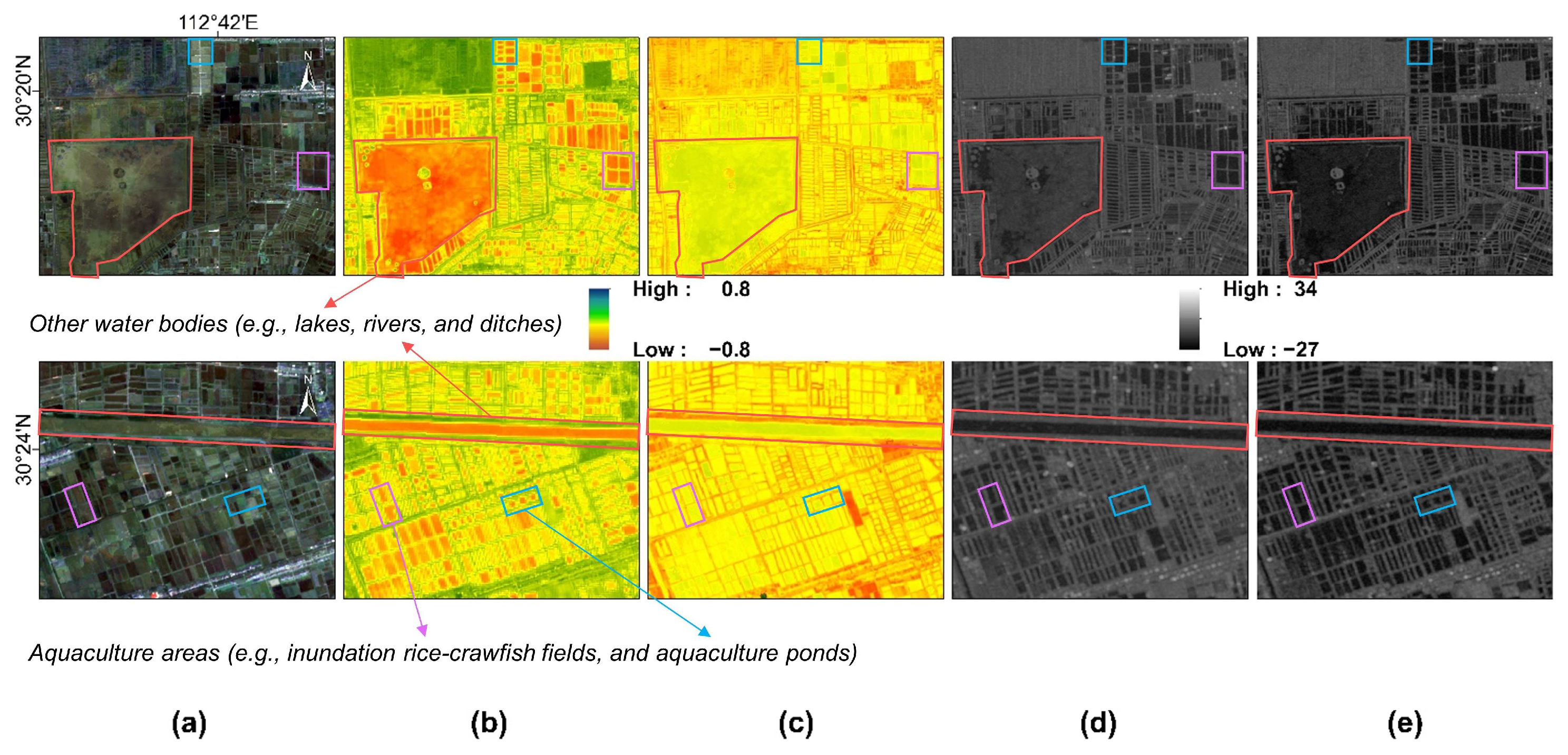
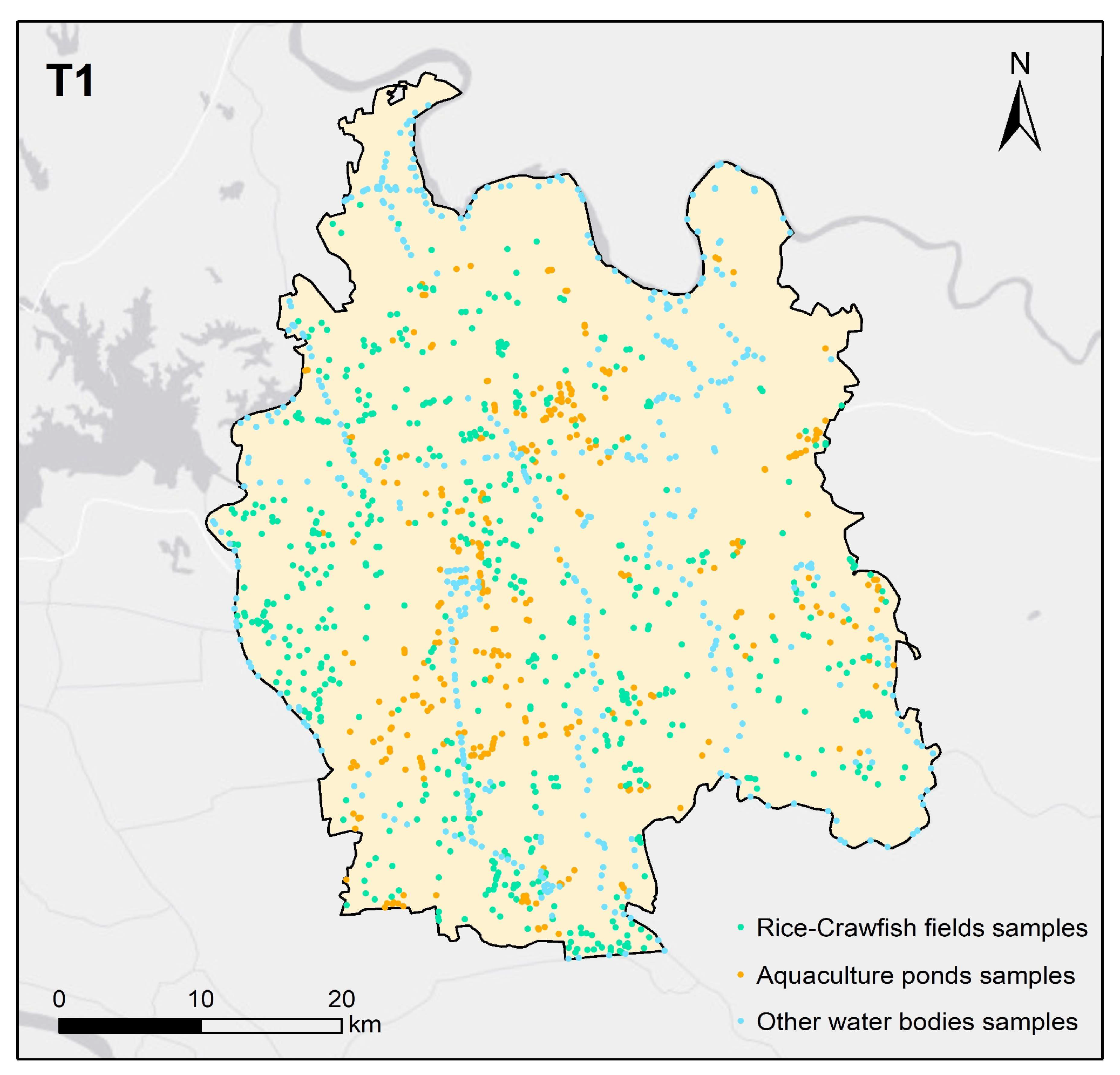


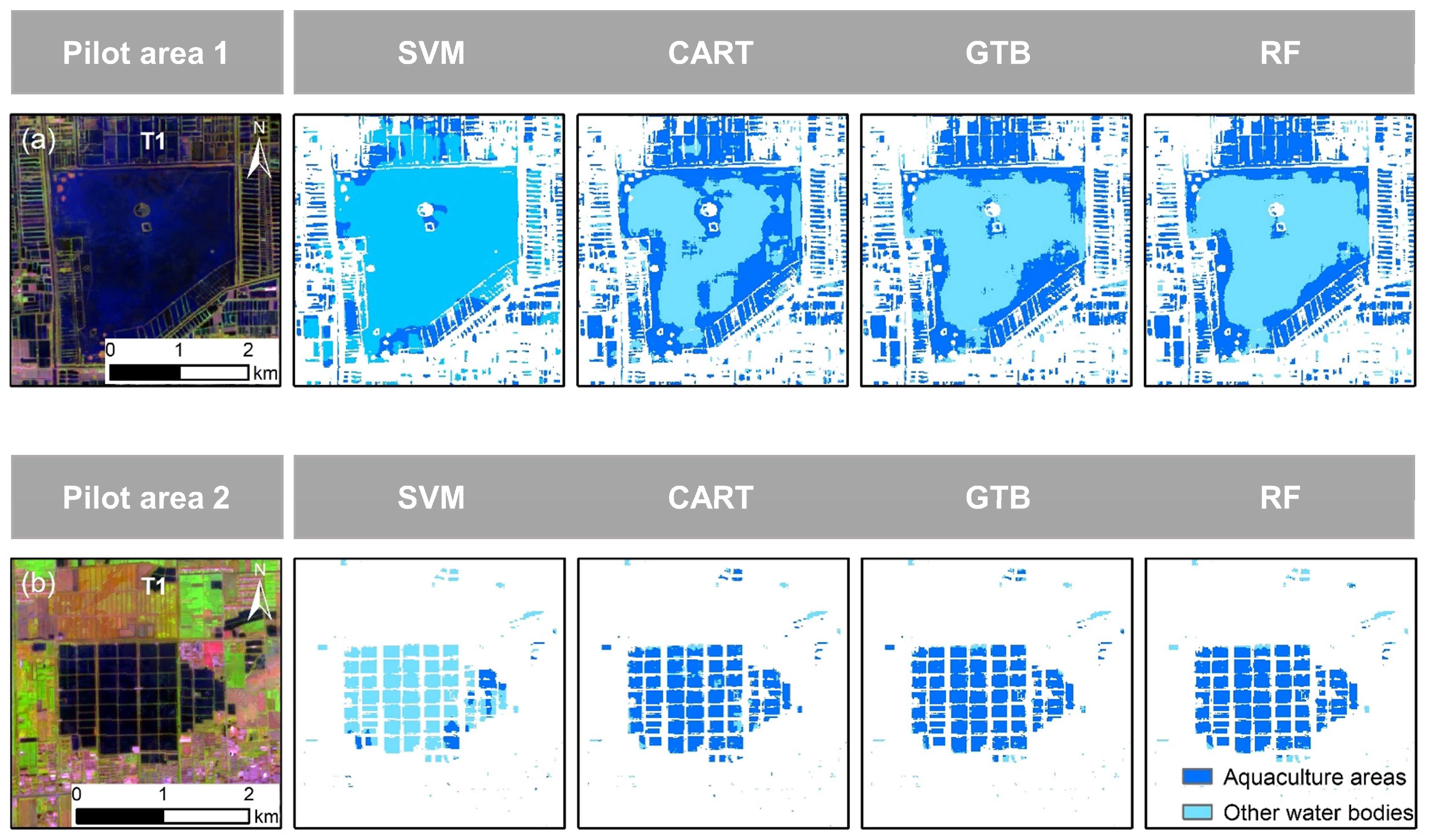
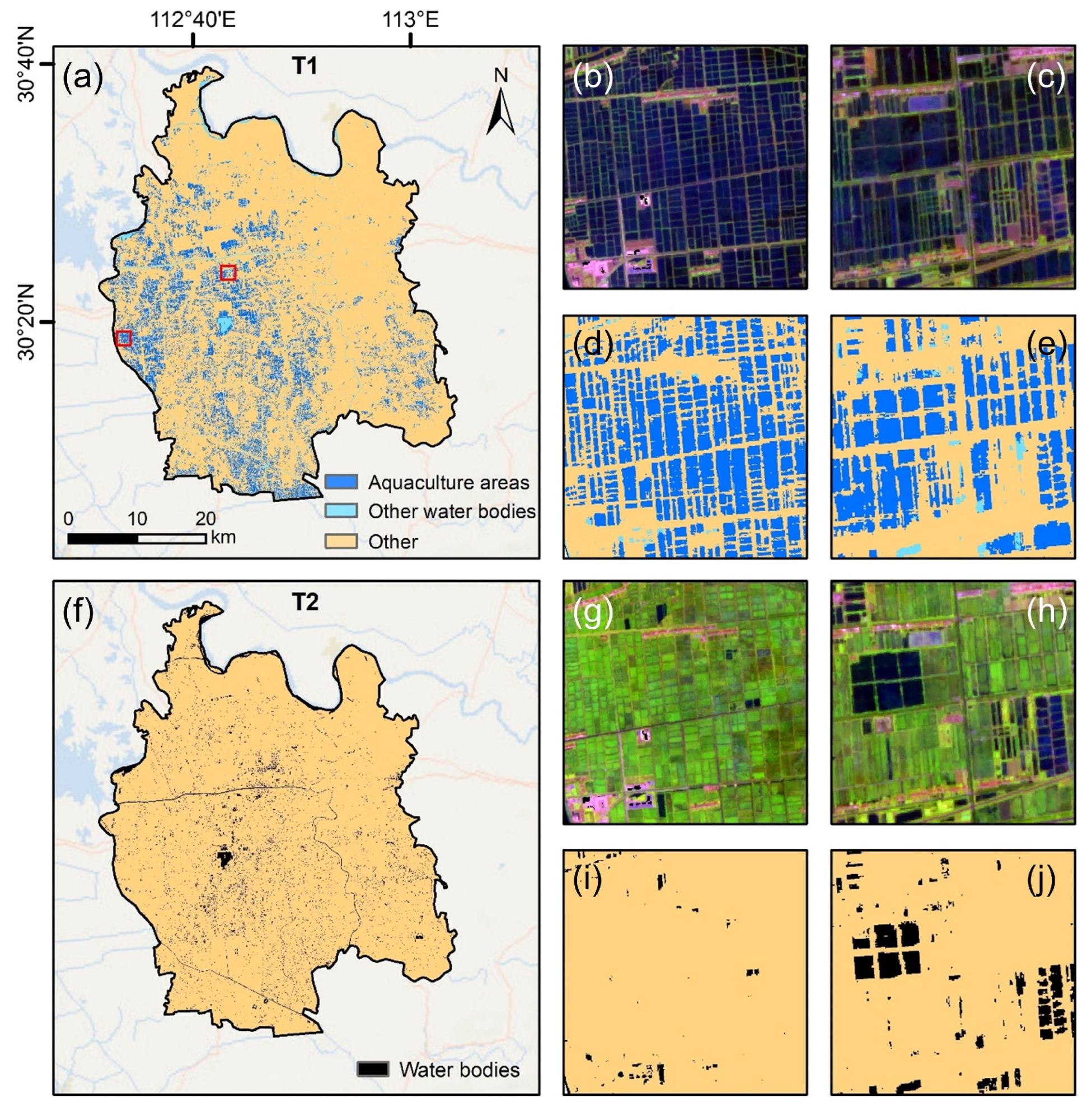
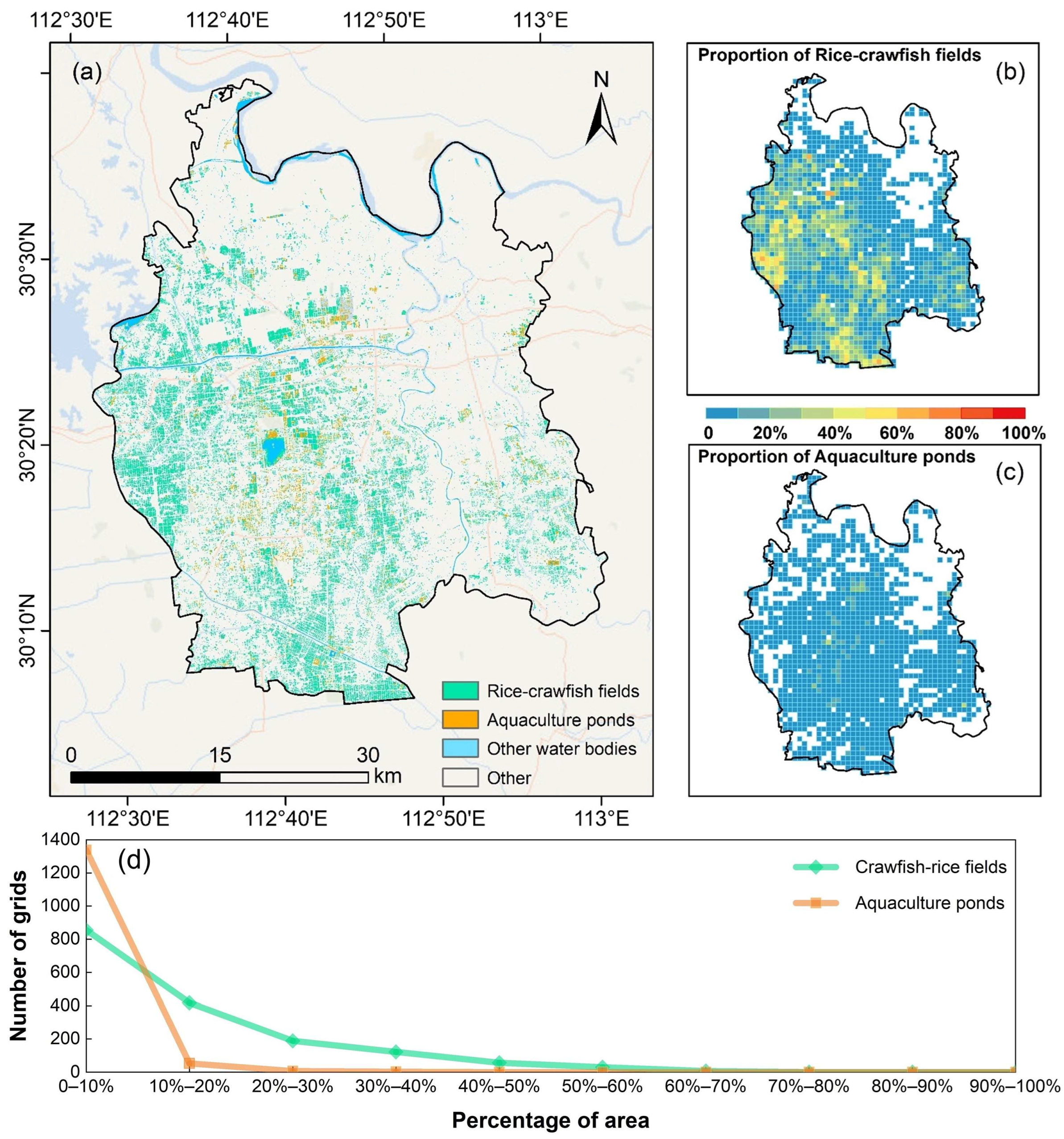
| Algorithms | Name in GEE | Name in Sklearn |
|---|---|---|
| Random Forest (RF) | numberOfTrees minLeafPopulation | n_estimators min_samples_leaf |
| Support Vector Machine (SVM) | cost shrinking | c shrinking |
| Classification and Regression Trees (CART) | maxNodes minLeafPopulation | max_depth min_samples_leaf |
| Gradient Boosting (GTB) | numberOfTrees shrinkage maxNodes | n_estimators learning_rate max_depth |
| Temporal Widow | Class | Amount |
| Temporal widow 1 | Aquaculture ponds | 325 |
| Rice-crawfish fields | 581 | |
| Other water bodies | 456 |
| Date | Class | RCF | AP | OW | Total | PA (%) | OA (%) | F1 Score |
|---|---|---|---|---|---|---|---|---|
| 2023 | RCF | 100 | 6 | 0 | 106 | 94.3 | 93.8 | 0.94 |
| AP | 2 | 63 | 2 | 67 | 94.0 | |||
| OW | 2 | 3 | 64 | 69 | 92.8 | |||
| Total | 104 | 72 | 66 | 242 | ||||
| UA (%) | 96.2 | 87.5 | 97.0 |
| Study | Study Area | Study Object | Data Source | Methodology | Accuracy Assessment |
|---|---|---|---|---|---|
| [5] | China’s coastal zone | Coastal aquaculture ponds | Sentinel-2 Level-1C (10m) | Object-based: Simple Non-Iterative Clustering (SNIC) + Hierarchical decision trees (HDT) | OA: 90.22–92.3% |
| [6] | Global landside | Landside clustering aquaculture ponds | Sentinel-2 Level-2A (10m) | Pixel-based: Edge detection and morphological | F1: 0.88 |
| [54] | China’s coastal zone | Coastal aquaculture ponds | Landsat 5 TM Landsat 7 ETM+ Landsat 8 OLI (30m) | Object-based: Image segmentation + Change detection | OA: 87–94% |
| [8] | Qianjiang, Hubei, China | Rice-crawfish fields | GF-2 Level-1A (1m) | Pixel-based: Deep convolutional network (RAUNet) | F1: 0.90 |
| [17] | Qianjiang, Hubei, China | Rice-crawfish fields | Landsat 7 ETM+ Landsat 8 OLI (30m) | Pixel-based + Object-based: Multiresolution segmentation (MRS) + Automated water extraction index (AWEIsh) + Phenological characteristics | OA: 92.80–96.5% |
| [18] | Qianjiang, Hubei, China | Rice + Rice-crawfish + Winter wheat + Winter rape + Other crops | GF-6 WFV (16m) Landsat-8 OLI (30m) Sentinel-2 (10m) | Pixel-based: Random Forest classifier + 255 spectral-temporal features | OA: 91.55% (GF-6) |
| This study | Qianjiang, Hubei, China | Inland freshwater aquaculture ponds + Rice-crawfish fields + Other water bodies | Sentinel-1 GRD Sentinel-2 Level-2A (10m) | Pixel-based: Random Forest classifier + Spectral features + Texture features + Phenological features + Hierarchical framework | OA: 93.80% F1: 0.94 |
Disclaimer/Publisher’s Note: The statements, opinions and data contained in all publications are solely those of the individual author(s) and contributor(s) and not of MDPI and/or the editor(s). MDPI and/or the editor(s) disclaim responsibility for any injury to people or property resulting from any ideas, methods, instructions or products referred to in the content. |
© 2024 by the authors. Licensee MDPI, Basel, Switzerland. This article is an open access article distributed under the terms and conditions of the Creative Commons Attribution (CC BY) license (https://creativecommons.org/licenses/by/4.0/).
Share and Cite
Wang, C.; Wang, G.; Zhang, G.; Cui, Y.; Zhang, X.; He, Y.; Zhou, Y. Freshwater Aquaculture Mapping in “Home of Chinese Crawfish” by Using a Hierarchical Classification Framework and Sentinel-1/2 Data. Remote Sens. 2024, 16, 893. https://doi.org/10.3390/rs16050893
Wang C, Wang G, Zhang G, Cui Y, Zhang X, He Y, Zhou Y. Freshwater Aquaculture Mapping in “Home of Chinese Crawfish” by Using a Hierarchical Classification Framework and Sentinel-1/2 Data. Remote Sensing. 2024; 16(5):893. https://doi.org/10.3390/rs16050893
Chicago/Turabian StyleWang, Chen, Genhou Wang, Geli Zhang, Yifeng Cui, Xi Zhang, Yingli He, and Yan Zhou. 2024. "Freshwater Aquaculture Mapping in “Home of Chinese Crawfish” by Using a Hierarchical Classification Framework and Sentinel-1/2 Data" Remote Sensing 16, no. 5: 893. https://doi.org/10.3390/rs16050893
APA StyleWang, C., Wang, G., Zhang, G., Cui, Y., Zhang, X., He, Y., & Zhou, Y. (2024). Freshwater Aquaculture Mapping in “Home of Chinese Crawfish” by Using a Hierarchical Classification Framework and Sentinel-1/2 Data. Remote Sensing, 16(5), 893. https://doi.org/10.3390/rs16050893








